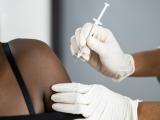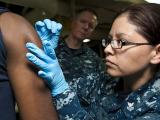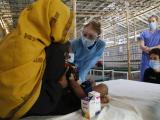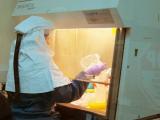Apr 19, 2005 (CIDRAP News) Giving people an anthrax shot and antibiotic treatment in the wake of an attack is probably the most cost-effective response to the threat of an anthrax assault on an American city, according to a new study.
The combination of postexposure vaccination and antibiotics is better than postexposure vaccination alone and also better than preemptive (pre-event) vaccination of the whole population, according to the analysis by Robert A. Fowler, MD, MS, of the University of Toronto and colleagues from Duke University and Stanford University.
"The savings associated with preventing cases of inhalational anthrax offset the cost of using both vaccination and antibiotics," states the report in today's issue of Annals of Internal Medicine.
The problem of defending civilians against an anthrax release became more than theoretical in 2001, when the anthrax mailings to senators' offices and media outlets killed five people and caused 17 more to get sick. More than 10,000 people who might have been exposed to anthrax during the episode were advised to take antibiotics.
Fowler and colleagues developed a computer model based on assumptions about the risk of an anthrax attack on a US city of 5 million and data on the costs, effectiveness, and side effects of anthrax vaccine and antibiotics. They assumed that the risk of a large-scale release of aerosolized anthrax is 1% per year and that 10% of the population would contract inhalational anthrax, which is nearly always fatal if not treated.
Immunization with the existing anthrax vaccine requires six shots over a period of 18 months. The researchers estimated that postexposure vaccination would be half as effective as the full six-shot series. Based on existing evidence, they assumed that appropriate antibiotic treatment would prevent disease in 80% of exposed people. They also assumed that 4% of people would have minor adverse reactions to the vaccine and that fewer than 1% would have moderate or severe reactions.
The model showed that the vaccine-and-antibiotics approach would prevent more illness cases, save more lives, and cost less than postexposure vaccination alone would. The savings amounted to 0.33 life-year and $355 per person, according to the report.
A nonstrategyno preventive measures before or after attackwas found to be the most expensive approach. "Costs were higher without vaccination or antibiotic prophylaxis because of the high cost of treating inhalational anthrax," the article says. Also, postexposure vaccination alone was less effective than postexposure antibiotic treatment alone.
Given the assumed anthrax-exposure risks and the risk of vaccine side effects, mass preemptive vaccination is not significantly more effective than no vaccination, according to the model. Preemptive vaccination would cost $163 per person, or $815 million for a city of 5 million, the report says.
However, pre-event vaccination could pay off if each person's risk of anthrax exposure were higher than the 1-in-1,000 assumed in the model. "[Preemptive] vaccination provides net benefit when the probability of clinically significant exposure reaches about 1 in 200," which would be true if the risk of attack were still 1% per year but the individual risk of exposure during an attack were 50% in stead of 10%. Pre-event vaccination could also be the better approach if the distribution of antibiotics after an attack were delayed.
In an editorial accompanying the article, Vanderbilt University mathematician Glenn F. Webb, PhD, says the study is an excellent analysis of the policy issues for one city. But he says the authors "may underestimate the incalculable societal impact of such an attack," and he wonders if panic and chaos would erupt in that situation.
Webb also says the analysis ignores the dominant role of the federal government in determining policy concerning bioterrorism preparedness, particularly given the limited supply of anthrax vaccine. At the current perceived level of risk of an anthrax attack, mass vaccination of the US population is unwarranted, he writes. But if the risk increased sharply, "preattack mass vaccination of the entire U.S. population may be the most rational strategy to prepare for a large-scale anthrax attack," he asserts.
Fowler RA, Sanders GD, Bravata DM, et al. Cost-effectiveness of defending against bioterrorism: a comparison of vaccination and antibiotic prophylaxis against anthrax. Ann Intern Med 2005;142(8):601-10 [Abstract]
Webb GF. Being prepared: modeling the response to an anthrax attack. Ann Intern Med 2005;142(8):667-8


















